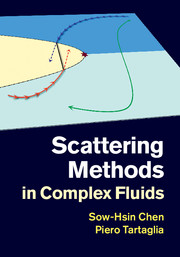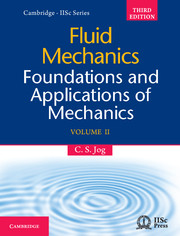3654 results in ebooks in fluid mechanics
Contents
-
- Book:
- Fluid Mechanics
- Published online:
- 05 May 2015
- Print publication:
- 25 June 2015, pp iii-vii
-
- Chapter
- Export citation
G - Fourier-series Expansion of some Functions
- from Appendices
-
- Book:
- Fluid Mechanics
- Published online:
- 05 May 2015
- Print publication:
- 25 June 2015, pp 509-542
-
- Chapter
- Export citation
Preface
-
- Book:
- Fluid Mechanics
- Published online:
- 05 May 2015
- Print publication:
- 25 June 2015, pp xvii-xviii
-
- Chapter
- Export citation
Answers and Hints to Selected Exercises
-
- Book:
- Fluid Mechanics
- Published online:
- 05 May 2015
- Print publication:
- 25 June 2015, pp 550-564
-
- Chapter
- Export citation
B - Governing Equations in Spherical Coordinates
- from Appendices
-
- Book:
- Fluid Mechanics
- Published online:
- 05 May 2015
- Print publication:
- 25 June 2015, pp 494-495
-
- Chapter
- Export citation

Scattering Methods in Complex Fluids
-
- Published online:
- 05 May 2015
- Print publication:
- 09 April 2015

Fluid Mechanics
- Foundations and Applications of Mechanics
-
- Published online:
- 05 May 2015
- Print publication:
- 25 June 2015
5 - Experiments on structural arrest
- from Part II - Structural arrest
-
- Book:
- Scattering Methods in Complex Fluids
- Published online:
- 05 May 2015
- Print publication:
- 09 April 2015, pp 157-178
-
- Chapter
- Export citation
Part III - Water
-
- Book:
- Scattering Methods in Complex Fluids
- Published online:
- 05 May 2015
- Print publication:
- 09 April 2015, pp 209-210
-
- Chapter
- Export citation
3 - Aggregation and cluster formation
- from Part I - Scattering and liquids
-
- Book:
- Scattering Methods in Complex Fluids
- Published online:
- 05 May 2015
- Print publication:
- 09 April 2015, pp 88-124
-
- Chapter
- Export citation
1 - Scattering techniques for the liquid state
- from Part I - Scattering and liquids
-
- Book:
- Scattering Methods in Complex Fluids
- Published online:
- 05 May 2015
- Print publication:
- 09 April 2015, pp 3-47
-
- Chapter
- Export citation
Part I - Scattering and liquids
-
- Book:
- Scattering Methods in Complex Fluids
- Published online:
- 05 May 2015
- Print publication:
- 09 April 2015, pp 1-2
-
- Chapter
- Export citation
Frontmatter
-
- Book:
- Scattering Methods in Complex Fluids
- Published online:
- 05 May 2015
- Print publication:
- 09 April 2015, pp i-iv
-
- Chapter
- Export citation
References
-
- Book:
- Scattering Methods in Complex Fluids
- Published online:
- 05 May 2015
- Print publication:
- 09 April 2015, pp 359-378
-
- Chapter
- Export citation
6 - Models of gel-forming colloids
- from Part II - Structural arrest
-
- Book:
- Scattering Methods in Complex Fluids
- Published online:
- 05 May 2015
- Print publication:
- 09 April 2015, pp 179-208
-
- Chapter
- Export citation
Contents
-
- Book:
- Scattering Methods in Complex Fluids
- Published online:
- 05 May 2015
- Print publication:
- 09 April 2015, pp v-viii
-
- Chapter
- Export citation
List of illustrations
-
- Book:
- Scattering Methods in Complex Fluids
- Published online:
- 05 May 2015
- Print publication:
- 09 April 2015, pp ix-xiv
-
- Chapter
- Export citation
2 - Statistical mechanics of the liquid state
- from Part I - Scattering and liquids
-
- Book:
- Scattering Methods in Complex Fluids
- Published online:
- 05 May 2015
- Print publication:
- 09 April 2015, pp 48-87
-
- Chapter
- Export citation
Index
-
- Book:
- Scattering Methods in Complex Fluids
- Published online:
- 05 May 2015
- Print publication:
- 09 April 2015, pp 379-382
-
- Chapter
- Export citation
Preface
-
- Book:
- Scattering Methods in Complex Fluids
- Published online:
- 05 May 2015
- Print publication:
- 09 April 2015, pp xv-xviii
-
- Chapter
- Export citation
